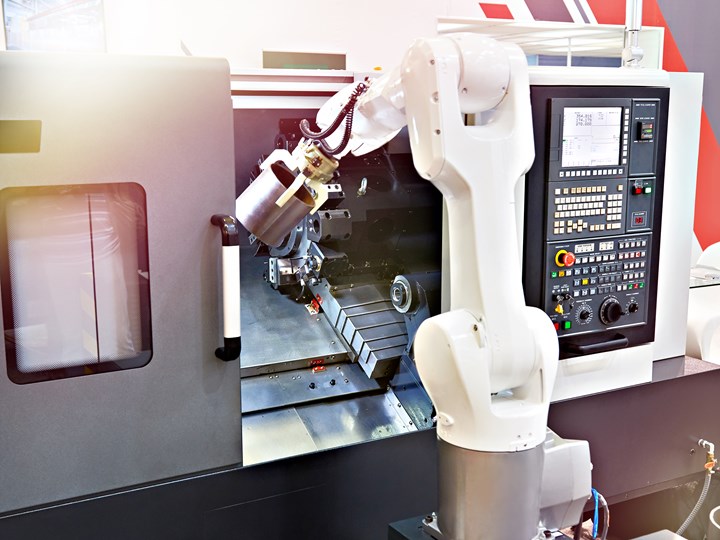The Effects of Automation on Manufacturing
Companies that are not currently using automation in their manufacturing processes should be considering it.

American manufacturing has weathered through some dark times over the last few decades, but recently it has been making a comeback. Part of its success can be attributed to the rise we are seeing in automation, robotics and advanced manufacturing. Today, manufacturing, machine tools and automation go hand in hand.
With the labor force in manufacturing declining and with ever-increasing wages in the U.S., many manufacturing companies turn to other countries for their production needs. But automation is slowly changing that mindset and the ability for U.S.-owned companies to be competitive. Automation in manufacturing is no magic wand, but it can certainly level the playing field. Companies that are not currently using automation in their manufacturing processes should definitely be considering it.
What exactly is automation? How is it helping our industry? How can it help you? It is defined as the use of largely automatic equipment in a system of manufacturing or other production processes.
Many people think of automation on a large scale; historically, that would be in environments such as the big three (Ford, Chrysler and GM). But automation can be added to machine tools in many other, more affordable ways as well. A shop can start with basic automation such as adding a bar feeder to a lathe and build from there, perhaps all the way to a complete, automated cell that handles the part from start to finish. Automation can include robots that load and unload machines or gantry systems that are mounted to the machine tool or as a stand-alone. Conveyors can move material from one place to the next with flip or turn stations that rotate a part for the next operation. The bottom line is that by automating a production facility, a shop can increase production, reduce cycle times, improve quality, reduce manufacturing lead times, create a safer workplace and become more competitive.
But certain challenges should be considered when implementing automation in the shop. Some of these concerns include floor space, cost, deciding what to automate, finding skilled employees and employee resistance.
Generally, the benefits to using automation outweigh the challenges, especially when it can increase efficiency and production. It’s realistic to see up to a 30-percent increase in production by using automation in the manufacturing process. A more efficient production process gives way to increased output and allows manufacturers in the U.S. to be more competitive. The Association for Advancing Automation stated in a “60 Minutes” segment entitled “March of the Machines” that American manufacturing’s embrace of robotics will ensure a new manufacturing renaissance in this country. I happen to believe this to be true, and I think manufacturers are embracing robots and their progressive technology.
On the other hand, some employees may feel like they will lose their job because of automation. This fear is far from being true as automation opens the door for employees to advance to new opportunities with the creation of new positions. Downtime in manufacturing creates a snowball effect that impacts all levels of production. When equipment fails, it needs to be back up and running as quickly as possible. The reliance on automation creates more demand for skilled maintenance and service technician jobs.
Matt Highfield, a director at Deloitte Consulting LLP who specializes in global location strategy, makes a valid point when he says factories of the future are going to be “lower touch” and more automated. They will have higher capital expenditures with a lower labor component, which will also translate to higher skills and higher paying jobs. In theory, those factories will be more efficient and will be able to produce more, as more automation is introduced.
Today, almost 56 percent of global companies do some type of automation. Automation has made us stronger, faster and more competitive and future possibilities are limitless. Now is the time to decide—is automation right for you? I say yes.
Automation will help provide a competitive edge/advantage, but it will not fix a production problem. In the metal machining industry, when a process is out of control or chip control is an issue, automation will not resolve those problems. So, as you do your homework and decide to automate one, two or several machines, make sure the machining process is solid.
Contributor
Jonathan Grigg is an applications engineer at Okuma America Corp.
Contact: 704-588-7000, okuma.com
Related Content
Reinventing the Wheel with Robot-Automated CNC Multitasking
One race team discovers how to efficiently manufacture a new wheel nut design for the next-generation NASCAR stock car with the help of a CNC mill/turn and a built-in robot.
Read MoreReplace Repetitive Measurement With DIY Robotic Automation
After minimal training, a shop can learn how to use this robotic inspection system configured for a shopfloor application to supersede repetitive, time-consuming, high-mix gaging processes. It can then be redeployed for another application somewhere else in the facility.
Read MoreHigh-Volume Machine Shop Automates Secondary Ops
An Ohio contract shop added a compact, self-loading CNC lathe to perform unattended secondary ops on a part for a key customer rather than running it on a manually loaded chucker.
Read MoreInside the Premium Machine Shop Making Fasteners
AMPG can’t help but take risks — its management doesn’t know how to run machines. But these risks have enabled it to become a runaway success in its market.
Read MoreRead Next
A Tooling Workshop Worth a Visit
Marubeni Citizen-Cincom’s tooling and accessory workshop offers a chance to learn more about ancillary devices that can boost machining efficiency and capability.
Read MoreEmerging Leaders Nominations Now Open
Here’s your chance to highlight a young person in your manufacturing business who is on the path to be a future leader moving your company forward.
Read MoreDo You Have Single Points of Failure?
Plans need to be in place before a catastrophic event occurs.
Read More













.jpg;maxWidth=300;quality=90)







